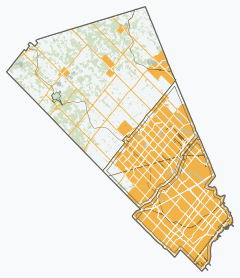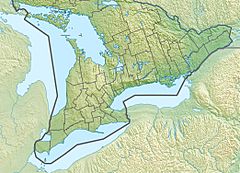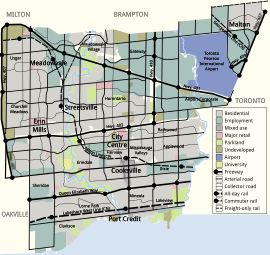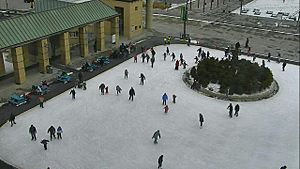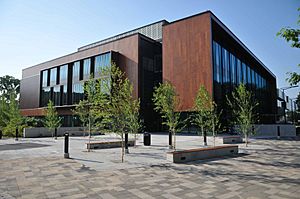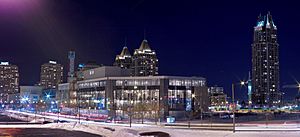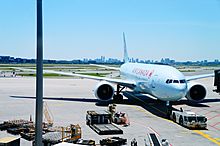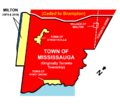Mississauga facts for kids
Quick facts for kids
Mississauga
|
|||||
|---|---|---|---|---|---|
| City of Mississauga | |||||
|
From top, left to right: Mississauga City Centre, the Mississauga Civic Centre, Port Credit, Health Sciences Complex at the University of Toronto Mississauga, Old Grammar School in Streetsville, the Credit River, and Absolute World towers.
|
|||||
|
|||||
| Motto(s):
Pride in our past, faith in our future Leading Today for Tomorrow
|
|||||
| Country | Canada | ||||
| Province | Ontario | ||||
| Region | Peel | ||||
| Established | 1968, as town | ||||
| Incorporated | 1974, as city | ||||
| Area | |||||
| • Total | 292.43 km2 (112.91 sq mi) | ||||
| Elevation | 156 m (512 ft) | ||||
| Population
(2021)
|
|||||
| • Total | 717,961 (7th) | ||||
| • Density | 2,467.60/km2 (6,391.1/sq mi) | ||||
| Time zone | UTC−05:00 (EST) | ||||
| • Summer (DST) | UTC−04:00 (EDT) | ||||
| Forward sortation area |
L4T to L5W & M7R
|
||||
| Area code(s) | 905, 289, 365, and 742 | ||||
| Demonym |
|
||||
| Website | www.mississauga.ca | ||||
Mississauga ( MISS-ih-SAW-gə) is a city in the Canadian province of Ontario. It is situated on the shores of Lake Ontario in the Regional Municipality of Peel, bordering Toronto to the east. With a population of 717,961 as of 2021, Mississauga is the sixth-most populous municipality in Canada, third-most in Ontario, and second-most in the Greater Toronto Area after Toronto itself. However, for the first time in its history, the city's population declined according to the 2021 census, from a 2016 population of 721,599 to 717,961, a 0.5 percent decrease.
The growth of Mississauga was attributed to its proximity to Toronto. During the latter half of the 20th century, the city attracted a multicultural population and built up a thriving central business district. Malton, a neighbourhood of the city located in its northeast end, is home to Toronto Pearson International Airport, Canada's busiest airport, as well as the headquarters of many Canadian and multinational corporations. Mississauga is not a traditional city, but is instead an amalgamation of three former villages, two townships, and a number of rural hamlets (a general pattern common to several suburban GTA cities) that were significant population centres, with none being clearly dominant, prior to the city's incorporation that later coalesced into a single urban area.
Indigenous people have lived in the area for thousands of years and Mississauga is situated on the traditional territory of the Huron-Wendat, Haudenosaunee and Anishinaabeg people, including the Mississaugas.
Contents
History
At the time of the arrival of the Europeans in the 1600s, both Iroquoian and Algonquian-speaking peoples already lived in the Credit River Valley area. One of the First Nations groups the French traders found around the Credit River area were the Algonquian Mississaugas, a tribe originally from the Georgian Bay area. The name "Mississauga" comes from the Anishinaabe word Misi-zaagiing, meaning "[Those at the] Great River-mouth." By 1700 the Mississaugas had driven away the Iroquois, yet during the Beaver Wars they played a neutral or post-emptive role.
Toronto Township, consisting of most of present-day Mississauga, was formed on 2 August 1805 when officials from York (what is now the City of Toronto) purchased 84,000 acres (340 km²) of land from the Mississaugas. In January 2010, the Mississaugas and the federal government settled a land claim, in which the band of aboriginal people received $145,000,000, as just compensation for their land and lost income.
The original villages (and some later incorporated towns) settled included: Lakeview, Clarkson, Cooksville, Dixie, Erindale (called Springfield until 1890), Lorne Park, Port Credit, Sheridan and Summerville. This region would become known as Toronto Township. Part of northeast Mississauga, including the Airport lands and Malton were part of Toronto Gore Township.
After the land was surveyed, the Crown gave much of it in the form of land grants to United Empire Loyalists who emigrated from the Thirteen Colonies during and after the American Revolution, as well as loyalists from New Brunswick. A group of settlers from New York City arrived in the 1830s. The government wanted to compensate the Loyalists for property lost in the colonies and encourage development of what was considered frontier. In 1820, the government purchased additional land from the Mississaugas. Additional settlements were established, including: Barbertown, Britannia, Burnhamthorpe, Derry West, Elmbank, Malton, Meadowvale Village, Mount Charles, and Streetsville. European-Canadian growth led to the eventual displacement of the Mississaugas. In 1847, the government relocated them to a reserve in the Grand River Valley, near present-day Hagersville.
In 1873, in light of the continued growth seen in this area much as a result of the many railway lines passing through the township which spurred on industry. The Toronto Township Council was formed to oversee the affairs of the various villages that were unincorporated at that time. The Council's responsibilities included road maintenance, and the constitution of a police force. Except for small villages, some gristmills and brickworks served by railway lines, most of present-day Mississauga was agricultural land, including fruit orchards, through much of the 19th and first half of the 20th century.
In the 1920s, cottages were constructed along the shores of Lake Ontario as weekend getaway houses for city dwellers.
17 years later in 1937, 1,410.8 acres of land was sold to build the Malton Airport (later known as the Pearson Airport). It became Canada's busiest airport which also put the end to the community of Elmbank.
The Queen Elizabeth Way (QEW) highway, one of the first controlled access highways in the world, opened from Highway 27 to Highway 10 in Port Credit, in 1935 and later expanded to Hamilton and Niagara in 1939. The first prototypical suburban developments occurred around the same time, in the area south of the Dixie Road/QEW interchange. Development in general moved north and west from there over time and around established communities. Large-scale developments, such as Erin Mills and Meadowvale sprang up in the 1968 and 1969 respectively.
The township settlements of Lakeview, Cooksville, Lorne Park, Clarkson, Erindale, Sheridan, Dixie, Meadowvale Village, and Malton were amalgamated by a somewhat unpopular provincial decree in 1968 to form the Town of Mississauga. At the time, both Port Credit and Streetsville were left out and remained as separate entities. The town name was chosen by plebiscite over "Sheridan". Political will, as well as a belief that a larger city would be a hegemony in Peel County, kept Port Credit and Streetsville as independent island towns encircled by the Town of Mississauga. In 1974, both were annexed by Mississauga when it reincorporated as a city. That year, the sprawling Square One Shopping Centre opened, which has since expanded many times.
On 10 November 1979, a 106-car freight train derailed on the CP rail line while carrying explosive and poisonous chemicals just north of the intersection of Mavis Road and Dundas Street. One of the tank cars carrying propane exploded, and since other tank cars were carrying chlorine, the decision was made to evacuate nearby residents. With the possibility of a deadly cloud of chlorine gas spreading through Mississauga, 218,000 people were evacuated.

Residents were allowed to return home, once the site was deemed safe. At the time, it was the largest peacetime evacuation in North American history. Due to the speed and efficiency in which it was conducted, many cities later studied and modelled their own emergency plans after Mississauga's. For many years afterwards, the name "Mississauga" was, to Canadians, associated with a major rail disaster.
North American telephone customers placing calls to Mississauga (and other post 1970 Ontario cities) may not recognise the charge details on their billings, as Bell Canada continues to use the historic community exchanges: Clarkson, Cooksville, Malton, Port Credit, and Streetsville, rather than "Mississauga"; they are combined as a single Mississauga listing in the phone book. Touch-Tone telephones were first introduced at Malton, the first in Canada, on 15 June 1964.
On 1 January 2010, Mississauga bought land from the Town of Milton and expanded its border by 400 acres (1.6 km2) to Hwy. 407 affecting 25 residents.
Geography
Mississauga covers 288.42 square kilometres (111.36 sq mi) of land, fronting 13 kilometres (8.1 mi) of shoreline on Lake Ontario.
Mississauga is bounded by Oakville and Milton to the west/southwest, Brampton to the north, Toronto to the east, and Lake Ontario to the south/south-east. Halton Hills borders Mississauga's north-west corner. With the exception of the southeast border with Toronto (Etobicoke Creek), Mississauga shares a land border with all previously mentioned municipalities.
Two major river valleys feed into the lake. The Credit River is by far the longest with the heaviest flow, it divides the western side of Mississauga from the central/eastern portions and enters the lake at the Port Credit harbour. The indented, mostly forested valley was inhabited by first nation peoples long before European exploration of the area. The valley is protected and maintained by the Credit Valley Conservation Authority (CVCA).
Etobicoke Creek forms part of the eastern border of Mississauga with the city of Toronto. North of there it passes through the western limits of Pearson Airport. There have been two aviation accidents, in 1978 and 2005 where aircraft overshot the runaway and slid into the Etobicoke creek banks. In 1954, heavy flooding resulted in some homes along the riverbank being swept into the lake after heavy rains from Hurricane Hazel. Since that storm, houses are no longer constructed along the floodplain. The creek and its tributaries are administered by the Toronto and Region Conservation Authority (TRCA).
Most land in Mississauga drains to either of the two main river systems, with the exception of the smaller Mary Fix and Cooksville Creeks which run roughly through the center of Mississauga entering the lake near Port Credit. Some small streams and reservoirs are part of the Sixteen Mile Creek system in the far north-west corner of the city, but these drain toward the lake in neighbouring Milton and Oakville.
The shoreline of former Glacial Lake Iroquois roughly follows the Dundas Street alignment, although it is not noticeable in some places but is more prominent in others, such as the site of the former brickyard (Shoreline Dr. near Mavis Rd.), the ancient shoreline promenteau affords a clear view of downtown Toronto and Lake Ontario on clear days. The land in Mississauga in ranges from a maximum elevation of 214 m (699 ft) ASL in the far western corner, near the Hwy. 407/401 junction, to a minimum elevation at the Lake Ontario shore of 76 m (249 ft) ASL.
Apart from the embankments of Credit River valley, it tributaries and the Iroquois shoreline, the only noticeable hills in Mississauga are actually part of the former Britannia Landfill, now a golf course on Terry Fox Drive.
Neighbourhoods/Areas
Mississauga has many different neighbourhoods including the incorporated townships. There are 23 neighbourhoods in Mississauga.
- Applewood
- Central Erin Mills
- Churchill Meadows/Erin Mills
- Credit Valley
- Clarkson/Lorne Park
- Cooksville
- East Credit
- Erindale
- Fairview
- Hurontario
- Lakeview
- Lisgar
- Malton
- Meadowvale
- Meadowvale Village
- Mineola
- Mississauga Valleys
- Port Credit
- Rathwood
- Sheridan
- Streetsville
Climate
Mississauga's climate is considered to be moderate, and is located in plant hardiness zone 6b. Under the Köppen climate classification, Mississauga has a humid continental climate (Dfa/Dfb). Summers can bring periods of high temperatures accompanied with high humidity. While the average daily high temperature in July and August is 27 °C (80.6 °F), temperatures can rise above 32 °C (89.6 °F). In an average summer, there are an average of 15.8 days where the temperature rises above 30 °C (86.0 °F). Winters can be cold with temperatures that are frequently below freezing. In January and February, the mean temperature is −6 °C (21.2 °F) although it is common for temperatures to fall to −15 °C (5.0 °F). In an average winter, there are an average of 3.9 days where the temperature falls below −20 °C (−4.0 °F). Occasionally, there can be brief periods of warmer weather during the winter season. Compared to the rest of Canada and Ontario, the amount of snowfall received during the season is relatively low. On average, Mississauga receives 108.5 centimetres (42.7 in) of snow per year and there are 44.4 days with measurable snowfall. The climate of Mississauga is officially represented by Pearson International Airport but because of its topography and large surface area conditions can differ depending on location: fog tends to be more common along the lakeshore and in the Credit River Valley at certain times of year, particularly during the spring and autumn.
During snowfalls when temperatures hover close to freezing, northern parts of the city, such as around Derry Road away from warmer Lake Ontario usually get more snow that sticks to the ground because of the lower temperatures. The reverse occurs when a strong storm approaches from the south kicking up lake effect snow, bringing higher snowfall totals to south Mississauga. The city usually experiences 6 months of snow free weather however there is the odd occurrence where snow does fall either in October or May. The Port Credit and Lakeview areas have a micro-climate more affected by the proximity of the open lake, warming winter temperatures as a result but it can be sharply cooler on spring and summer afternoons, this can also be the case in Clarkson, but with much less consistency.
Most thunderstorms are not severe but can occasionally bring violent winds. The last known tornado to cause significant damage touched down on 7 July 1985, when an F1 rated tornado struck an industrial park in the Meadowvale area (Argentia Road), heavily damaging some buildings and some parked tractor trailers. A relatively strong tornado tore a path across Mississauga (then part of Toronto Township) on 24 June 1923, cutting a swath from present-day Meadowvale to near Cooksville, killing 4 people and causing massive property damage in a time when most of Mississauga was still rural farmland dotted with fruit orchards.
| Climate data for Lester B. Pearson International Airport 1981–2010 (Brampton and North Mississauga) | |||||||||||||
|---|---|---|---|---|---|---|---|---|---|---|---|---|---|
| Month | Jan | Feb | Mar | Apr | May | Jun | Jul | Aug | Sep | Oct | Nov | Dec | Year |
| Record high humidex | 19.0 | 14.8 | 29.2 | 37.9 | 42.6 | 45.0 | 50.3 | 46.6 | 48.0 | 39.1 | 28.6 | 23.9 | 50.3 |
| Record high °C (°F) | 17.6 (63.7) |
17.7 (63.9) |
25.6 (78.1) |
31.1 (88.0) |
34.4 (93.9) |
36.7 (98.1) |
37.6 (99.7) |
38.3 (100.9) |
36.7 (98.1) |
31.6 (88.9) |
25.0 (77.0) |
20.0 (68.0) |
38.3 (100.9) |
| Average high °C (°F) | −1.5 (29.3) |
−0.4 (31.3) |
4.6 (40.3) |
12.2 (54.0) |
18.8 (65.8) |
24.2 (75.6) |
27.1 (80.8) |
26.0 (78.8) |
21.6 (70.9) |
14.3 (57.7) |
7.6 (45.7) |
1.4 (34.5) |
13.0 (55.4) |
| Daily mean °C (°F) | −5.5 (22.1) |
−4.5 (23.9) |
0.1 (32.2) |
7.1 (44.8) |
13.1 (55.6) |
18.6 (65.5) |
21.5 (70.7) |
20.6 (69.1) |
16.2 (61.2) |
9.5 (49.1) |
3.7 (38.7) |
−2.2 (28.0) |
8.2 (46.8) |
| Average low °C (°F) | −9.4 (15.1) |
−8.7 (16.3) |
−4.5 (23.9) |
1.9 (35.4) |
7.4 (45.3) |
13.0 (55.4) |
15.8 (60.4) |
15.1 (59.2) |
10.8 (51.4) |
4.6 (40.3) |
−0.2 (31.6) |
−5.8 (21.6) |
3.3 (37.9) |
| Record low °C (°F) | −31.3 (−24.3) |
−31.1 (−24.0) |
−28.9 (−20.0) |
−17.2 (1.0) |
−5.6 (21.9) |
0.6 (33.1) |
3.9 (39.0) |
1.1 (34.0) |
−3.9 (25.0) |
−8.3 (17.1) |
−18.3 (−0.9) |
−31.1 (−24.0) |
−31.3 (−24.3) |
| Record low wind chill | −44.7 | −38.9 | −36.2 | −25.4 | −9.5 | 0.0 | 0.0 | 0.0 | −8.0 | −13.5 | −25.4 | −38.5 | −44.7 |
| Average precipitation mm (inches) | 51.8 (2.04) |
47.7 (1.88) |
49.8 (1.96) |
68.5 (2.70) |
74.3 (2.93) |
71.5 (2.81) |
75.7 (2.98) |
78.1 (3.07) |
74.5 (2.93) |
61.1 (2.41) |
75.1 (2.96) |
57.9 (2.28) |
785.9 (30.94) |
| Average rainfall mm (inches) | 25.1 (0.99) |
24.3 (0.96) |
32.6 (1.28) |
63.0 (2.48) |
74.3 (2.93) |
71.5 (2.81) |
75.7 (2.98) |
78.1 (3.07) |
74.5 (2.93) |
60.6 (2.39) |
68.0 (2.68) |
34.0 (1.34) |
681.6 (26.83) |
| Average snowfall cm (inches) | 29.5 (11.6) |
24.0 (9.4) |
17.7 (7.0) |
4.5 (1.8) |
0.02 (0.01) |
0.0 (0.0) |
0.0 (0.0) |
0.0 (0.0) |
0.0 (0.0) |
0.4 (0.2) |
7.5 (3.0) |
24.9 (9.8) |
108.5 (42.7) |
| Average precipitation days (≥ 0.2 mm) | 15.1 | 11.6 | 12.4 | 12.5 | 12.5 | 10.8 | 10.4 | 10.2 | 10.5 | 12.1 | 13.2 | 14.8 | 145.9 |
| Average rainy days (≥ 0.2 mm) | 5.4 | 4.6 | 7.4 | 11.3 | 12.5 | 10.8 | 10.4 | 10.2 | 10.5 | 12.0 | 11.0 | 7.1 | 113.2 |
| Average snowy days (≥ 0.2 cm) | 12.1 | 9.4 | 6.8 | 2.4 | 0.03 | 0.0 | 0.0 | 0.0 | 0.0 | 0.3 | 3.4 | 10.0 | 44.4 |
| Average relative humidity (%) | 80.8 | 79.3 | 78.1 | 75.4 | 77.2 | 79.8 | 81.9 | 85.7 | 87.4 | 85.2 | 83.3 | 81.8 | 81.3 |
| Mean monthly sunshine hours | 79.7 | 112.2 | 159.4 | 204.4 | 228.2 | 249.7 | 294.4 | 274.5 | 215.7 | 163.7 | 94.2 | 86.2 | 2,161.4 |
| Percent possible sunshine | 27.6 | 38.0 | 43.2 | 50.8 | 50.1 | 54.1 | 63.0 | 63.4 | 57.4 | 47.8 | 32.0 | 30.9 | 46.5 |
| Source: Environment Canada | |||||||||||||
Demographics
| Historical populations | ||
|---|---|---|
| Year | Pop. | ±% |
| 1971 | 172,352 | — |
| 1976 | 250,017 | +45.1% |
| 1981 | 315,055 | +26.0% |
| 1986 | 374,005 | +18.7% |
| 1991 | 463,388 | +23.9% |
| 1996 | 544,382 | +17.5% |
| 2001 | 612,925 | +12.6% |
| 2006 | 668,549 | +9.1% |
| 2011 | 713,443 | +6.7% |
| 2016 | 721,599 | +1.1% |
| 2021 | 717,961 | −0.5% |
In the 2021 Census of Population conducted by Statistics Canada, Mississauga had a population of 717,961 living in 244,575 of its 254,089 total private dwellings, a change of -0.5% from its 2016 population of 721,599. With a land area of 292.74 km2 (113.03 sq mi), it had a population density of 2,452.6/km2 (6,352/sq mi) in 2021.
| Canada 2016 Census | Population | % | |
|---|---|---|---|
| Ethnicity group | European | 302,375 | 42.3 |
| South Asian | 165,765 | 23.2 | |
| Chinese | 54,090 | 7.6 | |
| Black | 47,005 | 6.6 | |
| Filipino | 36,570 | 5.1 | |
| Arab | 36,200 | 5.1 | |
| Latin American | 16,110 | 2.3 | |
| Southeast Asian | 14,795 | 2.1 | |
| Multiple visible minority | 13,370 | 1.9 | |
| Other visible minority | 9,050 | 1.3 | |
| West Asian | 7,910 | 1.1 | |
| Korean | 6,095 | 0.9 | |
| Indigenous | 4,175 | 0.6 | |
| Japanese | 1,965 | 0.3 | |
| Total population | 715,475 | 100.0 | |
| Canada 2016 Census | Population | % | |
|---|---|---|---|
| Ethnic origin | Indian | 110,220 | 15.4 |
| Canadian | 73,020 | 10.2 | |
| English | 66,250 | 9.3 | |
| Chinese | 64,965 | 9.1 | |
| Irish | 49,115 | 6.9 | |
| Scottish | 47,895 | 6.7 | |
| Italian | 44,840 | 6.3 | |
| Polish | 43,350 | 6.1 | |
| Filipino | 39,755 | 5.6 | |
| Pakistani | 35,660 | 5.0 | |
| Portuguese | 34,035 | 4.8 | |
| German | 26,305 | 3.7 | |
| French | 23,895 | 3.3 | |
| Jamaican | 23,820 | 3.3 | |
| Total population | 715,475 | 100.0 | |
About 52% of the population speaks a language other than English, and 52.4% of the population are members of a visible minority (non-white or non-indigenous). 18% of the population is under 14 years of age, compared to those of retirement age; 8.51%. The median (middle) age in Mississauga is 35.0.
Christianity is the majority faith of the city. The 2011 census indicated that 59.9% of the population are adherents, with Catholics constituting 36.9%, while the remaining 23.0% belong to various Protestant, Orthodox Christian, and other Christian groups. Other practiced faiths were Islam (11.9%), Hinduism (7.0%) Sikhism (3.4%), Buddhism (2.2%), and Judaism (0.3%). Those who claimed no religious affiliation made up 14.9% of the population.
| Religions in Mississauga | ||||
|---|---|---|---|---|
| Religion | Percent | |||
| Christianity | 59.9% | |||
| None | 14.9% | |||
| Islam | 11.9% | |||
| Hinduism | 7.0% | |||
| Sikhism | 3.4% | |||
| Distribution of religions throughout Mississauga | ||||
Languages
The 2011 census found that English was spoken as single mother tongue by 47.6% of the population. The next most common languages were Urdu (4.9%), Polish (4.1%), Punjabi (3.2%), Arabic (3.1%), Tagalog (2.8%), and Portuguese (2.5%).
| Mother tongue | Population | Percentage |
|---|---|---|
| English | 338,280 | 47.6% |
| French | 7,400 | 1.0% |
| Urdu | 34,925 | 4.9% |
| Polish | 29,065 | 4.1% |
| Punjabi | 22,880 | 3.2% |
| Arabic | 21,990 | 3.1% |
| Tagalog (Filipino) | 19,920 | 2.8% |
| Portuguese | 17,685 | 2.5% |
| Spanish | 15,885 | 2.2% |
| Chinese, not otherwise specified | 15,745 | 2.2% |
| Italian | 14,210 | 2.0% |
| Cantonese | 11,925 | 1.7% |
| Mandarin | 11,335 | 1.6% |
| Tamil | 10,230 | 1.4% |
| Vietnamese | 9,835 | 1.4% |
| Hindi | 9,250 | 1.3% |
| Gujarati | 8,010 | 1.1% |
| Ukrainian | 5,955 | 0.8% |
| Croatian | 5,500 | 0.8% |
| Korean | 5,300 | 0.7% |
| Mother tongue | Population | Percentage |
|---|---|---|
| Persian (Farsi) | 5,245 | 0.7% |
| Russian | 4,645 | 0.7% |
| Serbian | 3,830 | 0.5% |
| German | 3,705 | 0.5% |
| Bengali | 3,305 | 0.5% |
| Romanian | 3,075 | 0.4% |
| Greek | 2,700 | 0.4% |
| Albanian | 2,215 | 0.3% |
| Malayalam | 2,145 | 0.3% |
| Hungarian | 1,870 | 0.3% |
| Telugu | 1,515 | 0.2% |
| Sinhala | 1,310 | 0.2% |
| Macedonian | 1,255 | 0.2% |
| Turkish | 1,225 | 0.2% |
| Bosnian | 1,130 | 0.2% |
| Bulgarian | 1,120 | 0.2% |
| Malay | 1,090 | 0.2% |
| Marathi | 1,065 | 0.1% |
| Pashto | 1,010 | 0.1% |
| Sindhi | 1,000 | 0.1% |
Arts and culture
Mississauga has a growing arts community, which is promoted by the Mississauga Arts Council, which holds an annual awards ceremony, called the MARTYs, to celebrate the city's artists, filmmakers, writers and musicians.
Mississauga's largest festivities such as Canada Day Celebration, Mississauga Rotary Ribfest, Tree Lighting Ceremony, and New Years' Eve Bash generally occur in Celebration Square. The Canada Day celebration was attended by 130,000 people in 2012, the Ribfest has recorded 120,000 visitors in 2012, and the inaugural New Years' Eve in 2011 has attracted 30,000 spectators.
One of the most anticipated events in the city is Carassauga, a festival of cultures that occurs annually during mid-May. It is the second largest cultural festival in Canada. During 2013, 4014 performances took place and 300,000 people attended. Carassauga attempts to display the different cultures around the world by setting up pavilions for countries around Mississauga. Visitors get free public transportation with their ticket to tour the city and explore the different pavilions. Various countries showcase their culture through food stalls, dance performances and small vendors. The event largely takes place in the Hershey Centre, where an outdoor stage is set up amidst many tiny pavilions. Other venues include the Tomken Twin Arena, the Canadian Coptic Centre and the Frank McKechnie Community Centre.
There are also culture-specific festivals held in Celebration Square, including Fiesta Ng Kalayaan for the Philippines, Viet Summerfest for Vietnam, Muslimfest for the city's Muslim community, and Mosaic Festival, which is the largest South Asian multi-disciplinary arts festival in North America.
The village of Streetsville holds its annual Bread and Honey Festival every first weekend of June at Streetsville Memorial Park to commemorate the founding of the village of Streetsville. The festival has been incorporated in 1974, in response to amalgamation with the city of Mississauga. Activities include the Bread and Honey Race, which raises money for charities and local hospitals. It also has its own annual Canada Day celebrations, which are also held at Streetsville Memorial Park.
Another former town, Port Credit, Ontario holds multiple festivals throughout the year. During the summer, there are street performances on multiple venues scattered throughout the former town during Buskerfest. The town alsoholds a grand parade named "Paint the Town Red" during Canada Day. Finally, during August, the town holds the Mississauga Waterfront Festival, which includes concerts as well as family activities. During September, the Tim Hortons Southside Shuffle is being held to celebrate the town's Blues and Jazz Festival, which includes musical performances from local blues and jazz artists.
The community of Malton, which contains a significant number of Sikhs, holds its annual Khalsa Day parade, marching between Sri Guru Singh Sabha (Malton Gurdwara) and Sikh Spiritual Centre (Rexdale Gurdwara Sahib) in Toronto. This parade is attended by 100,000 people.
Mississauga has a significant number of Jews, with active community classes, cultural activities and holiday celebrations.
Attractions
Mississauga Celebration Square
In 2006, with the help of Project for Public Spaces, the city started hosting "My Mississauga" summer festivities at its Civic Square. Mississauga planned over 60 free events to bring more people to the city square. The square was transformed and included a movable stage, a snack bar, extra seating, and sports and gaming facilities (basketball nets, hockey arena, chess and checker boards) including a skate park. Some of the events included Senior's day on Tuesday, Family day on Wednesday, Vintage car Thursdays, with the main events being the Canada Day celebration, Rotary Ribfest, Tree Lighting Ceremony, and Beachfest.
Civic Square has completed its restructuring project using federal stimulus money, which features a permanent stage, a larger ice rink (which also serves as a fountain and wading pool during the summer season), media screens, and a permanent restaurant. It officially reopened at 22 June 2011 and has since been renamed as Mississauga Celebration Square. More events have been added such as holding free outdoor live concerts, and live telecast of UEFA European Football Championship. The square also holds weekly programming such as fitness classes, amphitheatre performances and movie nights during the summer, children's activities during spring and fall, and skate parties during the winter. The opening of the square has also allowed the city to hold its first annual New Years' Eve celebration in 2011.
The upper and lower parts of the square used to be separated by a segment of City Centre Drive. However, pedestrian safety issues and commitment to building a vibrant downtown led the city council to permanently close this segment, uniting the upper and lower parts of the square.
In October 2012, the square had attracted its one millionth visitor.
Art Gallery of Mississauga
The Art Gallery of Mississauga (AGM) is a public, not-for-profit art gallery located in the Mississauga Civic Centre right on Celebration Square across from the Living Arts Centre and Square One Shopping Centre. AGM is sponsored by the City of Mississauga, Canada Council for the Arts, Ontario Trillium Foundation and the Ontario Arts Council. The art gallery offers free admission and tours and is open everyday. AGM has over 500 copies and is working on creating a digital gallery led by gallery assistant Aaron Guravich.
Shopping
Mississauga also boasts one of the largest shopping malls in Canada called Square One Shopping Centre, located at the City Centre. It has 350+ retail stores and services and attracts 24 million annual visits. It is operating on most holidays (the exceptions being Good Friday, Easter Sunday and Christmas Day), making it the only shopping mall in the city and one of the few in the Greater Toronto Area that do so. The mall is surrounded by several bars and restaurants, as well as the City Hall, the Central Library, and Playdium.
Erin Mills Town Centre, the second largest mall in Mississauga. It is located at the western edge of the city, near Eglinton Avenue at Erin Mills Parkway. The mall used to be notable by a clock tower placed in the center of the building. As its successor, the clock has been replaced with an iconic glass sphere (283 feet in circumference), as a part of the mall's $100 million redevelopment project. The mall also used to have a movie theatre, a mini-golf course, and a daycare centre, all of which were converted to retail space.
Located at the southeastern corner of the city is the Dixie Outlet Mall, which is Canada's largest enclosed outlet mall. It opened in 1956, making it Mississauga's first shopping mall, even though the city at that time was still known as Toronto Township, Ontario. Many factory outlets of premium brands are located in this mall. As a supporter of Bullfrog Power, it operates using 100% renewable energy. A flea market, the Fantastic Flea Market, is Mississauga's oldest flea market, which opened in 1976.
Erin Mills Town Centre and Dixie Outlet Mall are both closed for most holidays, except for Civic Holiday.
Sports
Mississauga's Paramount Fine Foods Centre (formerly the Hershey Centre) is the city's main sports venue. It is the home arena for Mississauga's minor league teams, the Raptors 905 of the NBA G League and the Mississauga Steelheads of the Ontario Hockey League. The arena was originally built for Mississauga's first OHL team, the Mississauga Icedogs, before they moved to St. Catharines and became the Niagara IceDogs. The Steelheads are the rebranded Mississauga St. Michael's Majors who had moved from Toronto in 2007. The arena was formerly the home of the Mississauga MetroStars of the MASL. It formerly was the home arena for the Mississauga Power of the National Basketball League of Canada before the team dissolved in 2015 after the announcement of the Raptors 905. In 2018, Mississauga's City Council approved a motion to study the feasibility and business case for construction of a new stadium in Mississauga with the hope of gaining a new CPL Team.
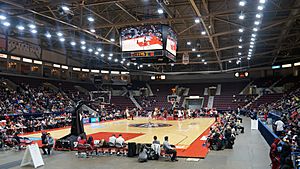
Other hockey teams in Mississauga include the Mississauga Chiefs of the Canadian Women's Hockey League (who play at Iceland Mississauga), the Mississauga Chargers of the Ontario Provincial Junior A Hockey League (who play at Port Credit Arena), and the many teams in the Greater Toronto Hockey League, Mississauga Hockey League, and Mississauga Girls Hockey League that play in the city's 13 arenas. In addition, there is a roller hockey team, the Mississauga Rattlers of the Great Lakes Inline Junior "A" Roller Hockey League Mississauga also has teams for box lacrosse (Mississauga Tomahawks of the OLA Junior A Lacrosse League), cricket (Mississauga Ramblers of the Toronto and District Cricket League, Mississauga Titans of the Etobicoke District Cricket League), and Canadian football. The Mississauga Football League (MFL) is a youth football program that is for players aged 7–17, founded in 1971. The city also has other amateur football teams in Ontario leagues: the Mississauga Warriors of the Ontario Varsity Football League and the Mississauga Demons of the Ontario Australian Football League. Mississauga's rugby players are now served by the Mississauga Blues through u7 - u17 Youth And Junior Programs as well as hosting one or more Senior Men's and Senior Women's Teams.
Ringette is one of the affiliated youth groups that are allocated ice time by the City of Mississauga (Recreation and Parks Division, Community Services Department) on an allocated priority basis. The Ringette program is administered by the Mississauga Ringette Association.
Mississauga Marathon, a qualifier race for the Boston Marathon, is held in Mississauga annually.
Mississauga is also the host for the 2022 Ontario Summer Games, and the Ontario ParaSport Games.
Sister cities
Mississauga has one sister city:
 Kariya, Aichi, Japan
Kariya, Aichi, Japan
Economy
Over 60 of the Fortune 500 companies base their global or Canadian head offices in Mississauga. Some of the strongest industries are pharmaceuticals, banking and finance, electronics and computers, aerospace, transportation parts and equipment industries.
TD Bank also has Corporate IT development centres in the city along with Royal Bank of Canada. Laura Secord Chocolates is headquartered in the city, and Hewlett Packard's main Canada offices are also in Mississauga. Regional airline Jazz operates a regional office in Mississauga and Kam Air has its North American office in Mississauga. Mississauga is also an aircraft development hub with Canadian headquarters of Aerospace companies such as Magellan Aerospace and Honeywell Aerospace. In addition Walmart Canada, Kellogg's Canada and Panasonic Canada have their national head offices in the city.
Education
Mississauga is the home to the University of Toronto Mississauga, one of three campuses of the University of Toronto. UTM has an enrollment of approximately 13,200 students. It is growing at a rate of about 1,000 students per year since 2002, following a major expansion. U of T Mississauga has 15 academic departments, 143 programs and 87 areas of study, and includes Institutes for Management and Innovation, and Communication, Culture, Information and Technology. The Mississauga Academy of Medicine is located on campus in the Terrence Donnelly Health Sciences Complex. The campus employs over 2,000 full- and part-time employees (including 800 permanent faculty and staff), and has more than 47,000 alumni, including astronaut Dr. Roberta Bondar, filmmaker Richie Mehta, actor Zaib Shaikh and writer/poet Dionne Brand. The $35-million Innovation Complex, which opened in September 2014, houses the Institute for Management and Innovation, a new model for business education combining management studies with key industry sectors, and the first phase of the multi-phase North Building reconstruction, known as Deerfield Hall, opened in September 2014.
Sheridan College opened a new $46 million facility in Mississauga in 2011. The school has two main concentrations: business education, and programs to accelerate the movement of new Canadians into the workforce. The 150,000 sq ft (14,000 m2) campus will be located on an 8.5-acre (34,000 m2) parcel of land in City Centre just north of the Living Arts Centre. The campus accommodated 1,700 students upon completion of phase one of construction in Fall 2011. Phase two of construction after 2011 increased capacity by 3,740 students to a combined total of 5,000; it also included construction of a 10-level municipal parking garage.
Mississauga is served by the Peel District School Board, which operates the secular Anglophone public schools, the Dufferin-Peel Catholic District School Board, which operates Catholic Anglophone public schools, the Conseil scolaire Viamonde, which operates secular Francophone schools, and the Conseil scolaire de district catholique Centre-Sud, which operates Catholic Francophone schools. Within the city, the four boards run a total of more than 150 schools.
Multiple schools in Mississauga also offer specialized programs:
- French immersion schools in multiple locations across the city such as Applewood Heights Secondary School, Clarkson Secondary School and Streetsville Secondary School
- Extended French Program at St. Thomas More School, Lorne Park Secondary School, Philip Pocock Catholic Secondary School and St. Aloysius Gonzaga Secondary School
- Regional Arts Program at Queen Elizabeth Senior Public School, Cawthra Park Secondary School and Iona Catholic Secondary School
- International Business and Technology Program at Allan A. Martin Senior Public School and Gordon Graydon Memorial Secondary School
- International Baccalaureate Program at St. Francis Xavier Secondary School, Glenforest Secondary School, Bronte College and Erindale Secondary School.
- Sci Tech Program at Tomken Road Middle School and Port Credit Secondary School
- Regional Enhanced Program at Glenforest Secondary School, The Woodlands School and Lorne Park Secondary School.
- Regional Sports Program at Applewood Heights Secondary School
- International and Executive Leadership Academy at TL Kennedy Secondary School
Infrastructure
Transportation
Rail
Mississauga is on three major railway lines (one each owned by the Canadian National Railway, the Canadian Pacific Railway, and Metrolinx). Toronto–Sarnia Via Rail trains on the Quebec City-Windsor Corridor pass through Mississauga and make request stops at Malton GO Station in the northeast of the city. Other Via Rail services stop in the neighbouring cities of Brampton, Oakville, and Toronto.
Commuter rail
Commuter rail service is provided by GO Transit, a division of Metrolinx, on the Lakeshore West, Kitchener, and Milton lines. All-day service is provided along the Lakeshore West line, while the Kitchener and Milton lines serve commuters going to and from Toronto's Union Station during rush hours.
Bus
The city's public transit service, MiWay (formerly Mississauga Transit), provides bus service along more than 90 routes across the city, and connects to commuter rail with GO Transit as well as with Brampton Transit, Oakville Transit, and the Toronto Transit Commission (TTC). MiWay operates routes for both local service (branded as "MiLocal") and limited-stop service (branded as "MiExpress").
Intercity buses operated by GO Transit stop at GO Train stations throughout the city and the Square One Bus Terminal.
Mississauga Transitway
A 12-station busway similar to Ottawa's Transitway was built parallel to Highway 403 from Winston Churchill Boulevard to Renforth Avenue, via the Mississauga City Centre Transit Terminal. Opened in stages, the Mississauga Transitway was completed on 22 November 2017 with the opening of the final station: Renforth. The service also connects to Kipling Subway Station in Toronto, via mixed lane traffic after Renforth station.
Hurontario LRT
There are plans for the construction of an LRT line along Hurontario Street stretching from Port Credit to southern Brampton, and possibly to Brampton's downtown. The project went through the Transit Project Assessment Process (TPAP) which includes environmental assessment. The line will be fully funded by the provincial government, with construction set to begin in 2018. Rapid transit lines could possibly be built on some other main thoroughfares, namely Dundas Street and Lakeshore Road, but no definite dates have been set.
Toronto Subway
In addition to the 19 km light rail line, there are plans to extend Line 5 Eglinton to Renforth Gateway and Toronto Pearson International Airport though eastern Mississauga by 2030-2031 bringing the Toronto Subway into Mississauga. There will be 4 stops in the city at Renforth Gateway connecting with the Mississauga Transitway and serving the Airport Corporate Centre, Convair serving the GTAA headquarters and airfield and aircraft maintenance areas, Silver Dart serving rental car facilities and airport hotels, and Pearson Airport serving the airport at a future transit hub.
Highways
Highway 401 (or the Macdonald-Cartier Freeway, connecting Windsor to the Quebec border) passes through the city's north end. The eastern part uses the collector/express lane system and feeds into Highway 403, the main freeway in the city, which runs through the City Centre and Erin Mills areas. The Queen Elizabeth Way, the city's first freeway, runs through the southern half of the city. These three freeways each run east–west, with the exception of the 403 from the 401 to Cawthra Road, and from the 407 to QEW. North of the 401, the collector lanes of the 403 become Highway 410, which goes to Brampton. Part of Highway 409 is within the city of Mississauga, and it provides access to Pearson Airport. Two other freeways run along or close to Mississauga's municipal borders. Highway 407 runs metres from the northern city limits in a power transmission corridor and forms the city's boundary with Milton between highways 401 and 403. Highway 427 forms the Toronto-Mississauga boundary in the northeast, and is always within 2 kilometres of the boundary further south, with the exception of the area around Centennial Park.
Air
Lester B. Pearson International Airport (YYZ), operated by the Greater Toronto Airports Authority in the northeastern part of the city, is the largest and busiest airport in Canada. In 2015, it handled 41,036,847 passengers and 443,958 aircraft movements. It is a major North American global gateway, handling more international passengers than any airport in North America other than John F. Kennedy International Airport. Pearson is the main hub for Air Canada, and a hub for passenger airline WestJet and cargo airline FedEx Express. It is served by over 75 airlines, having over 180 destinations.
Bicycle
In 2010, the City of Mississauga approved a Cycling Master Plan outlining a strategy to develop over 900 kilometres (560 miles) of on and off-road cycling routes in the city over the next 20 years. Over 1,000 Mississauga citizens and stakeholders contributed their thoughts and ideas to help develop this plan. The plan focuses on fostering cycling as a way of life in the city, building an integrated network of cycling routes and aims to adopt a safety first approach to cycling.
Emergency services
Peel Regional Police provide policing within the city of Mississauga and airport. In addition, the Ontario Provincial Police have a Port Credit detachment in the city for patrolling provincial highways. Mississauga Fire and Emergency Services provide fire fighting services and Peel Regional Paramedic Services provides emergency medical services. Toronto Pearson also has its own fire department with two halls that service calls within the airport grounds.
Healthcare
The city's two main hospitals—Credit Valley Hospital and Mississauga Hospital—were amalgamated into the Trillium Health Partners hospital group in December 2011. The health system and the administration for students in Mississauga was the property of the Peel District School Board Health Centre and the health support for citizens in Mississauga was the property of Peel Health Centre. The eastern part of Mississauga was the property of Pearson Health (Greater Toronto Area Health Department).
Notable people
Images for kids
-
The areas amalgamated to create the present city: The Town of Mississauga (red), was created out of Toronto Township, which in 1952 annexed a portion of Toronto Gore Township (right of dashed white line). In 1968 (the year of its incorporation), the police village of Malton (white outline) was absorbed into it. The town became a city in 1974, and absorbed Port Credit, Streetsville, and a portion of Milton (beige), but ceded the northern extremity (separated section of red at top) to Brampton. A final annexation occurred in 2010, when a thin strip of land was purchased from Milton (blue) to bring the city limits to Hwy. 407.
-
The Credit River
-
Absolute World, condominiums in Mississauga
See also
 In Spanish: Mississauga para niños
In Spanish: Mississauga para niños











